Don’t let sitting at work make your body stiff and sore! Use these quick and easy stretches to increase your range of motion, prevent injury, and help you feel more energized and focused.
If you sit all day long in an office, you could be sacrificing your effectiveness in the gym, or even putting yourself at risk for injury. Continuous sitting causes certain muscles to tighten up over time, becoming so stiff they pull on your skeletal system and alter your posture, making various movements in the gym and everyday life much harder.
The good news is you can avoid all this with some quick and easy stretches. All it takes is a few moments out of your workday every hour or so to perform these movements, all of which you can do right at your desk. Do them regularly, and you can kiss stiff muscles and weak posture goodbye.
1. Neck Stretch
You’ve probably noticed the shoulder and neck muscles are the first to tighten up after a long day of work, so start by rolling these out.
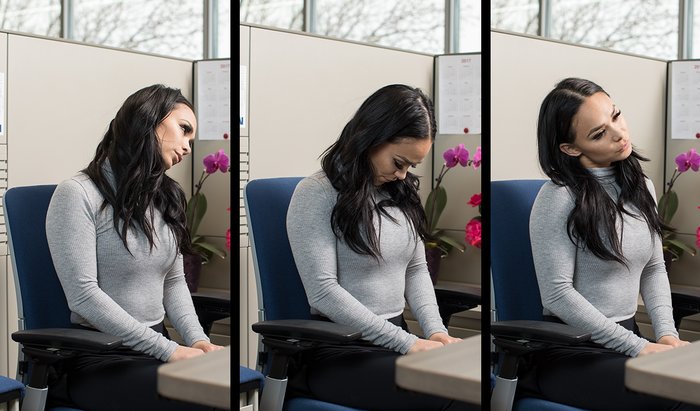
Sit upright with both feet flat on the floor and your back straight. Take a few deep breaths in and out. Once comfortable, slowly roll your head to one side and then roll it forward, chin to chest, following in a circle to the other side. Repeat this slow and controlled movement pattern as you roll back to the first side. Never roll your head directly to the back.
Hold the stretch for 10-15 seconds on each side, and repeat as necessary.
2. Side Stretch
Sit up straight in your chair and bring both arms above your head. Clasp your hands together. Gently shift your hands over to one side as you rotate the lower part of your shoulder blade up toward the ceiling. This should have you feeling a deep stretch in your underarm and lat region.
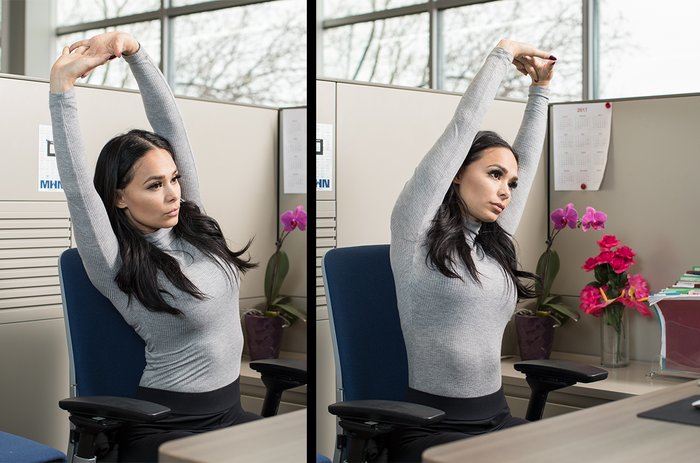
Hold this for 20-30 seconds, then switch sides and repeat.
3. Hamstring Stretch
The hamstrings are one of the highest risk muscle groups for becoming tight and shortened due to long sedentary periods.
To stretch the hamstrings, simply stand up out of your chair (step back about a foot or two) and lean forward, placing your forearms on the desk.
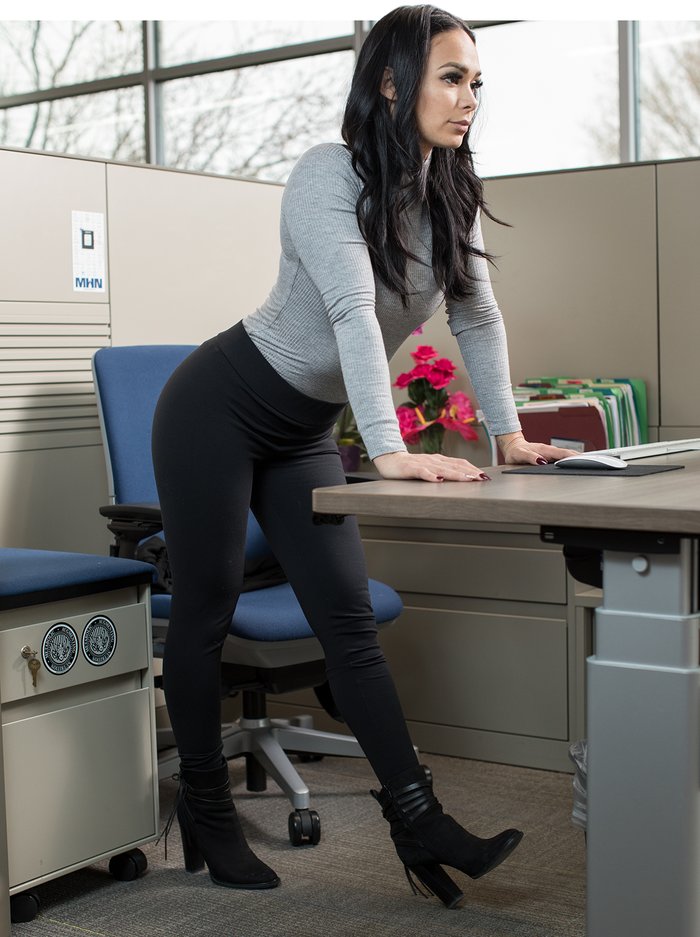
Once you are in this position, maintain a flat back as you straighten your knees and press your hip bones up toward the ceiling. You should feel a nice deep stretch in your hamstring muscles.
If you are more flexible, omit the desk and just bend straight down toward your toes, keeping your legs straight. Hold this position for 15-30 seconds.
4. Back Stretch
If your lower back feels tight while you’re sitting at your desk, a back stretch might be in order.
While in the seated position, cross one leg over the other in a comfortable manner. Now take the arm opposite the crossed leg and place it on the outer side of the knee. Twist your shoulders to face that direction and feel a stretch all through your spinal column.

Hold this position for 10-15 seconds, then switch sides and repeat. Remember to take deep breaths in and out as you perform the stretch. This will help ensure that you aren’t holding any extra tension in your back that could prevent you from deepening the stretch.
5. Upper-Back Stretch
Sit upright. Place both hands together in front of your body, hands clasped parallel to your shoulders.
Now round your upper back as you envision an imaginary string pulling your back toward the wall behind you as you simultaneously reach forward.
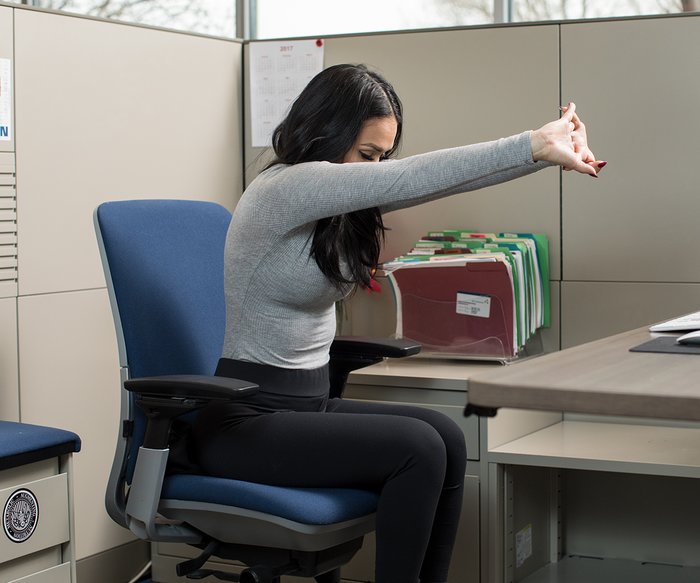
Hold this position for 30 seconds, feeling the muscles in your upper back and shoulders relax.
Once you’ve finished, come out of the stretch. Repeat throughout the day, as necessary.
6. Hip-Flexor Stretch
Finally, a main muscle group you should stretch at work is your hip flexors. These muscles get quite tight and tense while you’re sitting at your desk all day. You may notice they limit your range of motion on such exercises as squats and lunges. Tight hip flexors can also cause your hips to rotate forward, potentially altering your spinal column position and eventually contributing to the development of lower-back pain.
To stretch your hip flexors, stand up and place one foot on top of the chair.
If your office chair is immobile, that’s perfect. If not, put something in front it so it doesn’t roll forward.
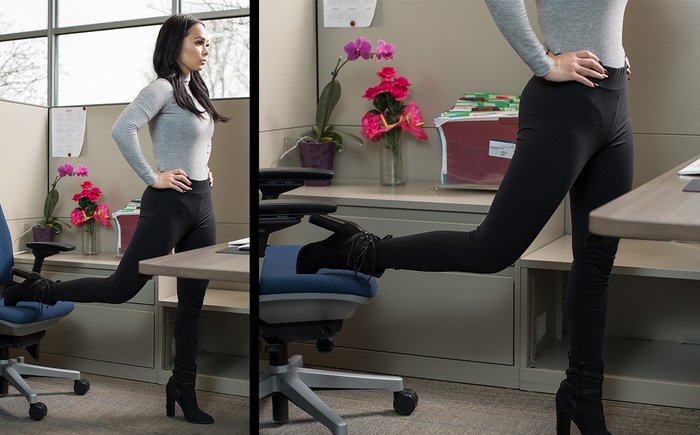
Now, keeping your foot on top of the seat of the chair, shift forward onto your standing leg, bringing your back hip forward as well. You will feel a nice stretch through the hip flexor of that back leg. It is very important to keep your lower back as straight as possible, so activate your core by pulling your belly button back toward your spine.
Hold this for 10-15 seconds, then switch sides and repeat. Do this a second time if your hips feel particularly tight.
Now that you’ve practiced these exercises, it’s time to create a quick office-desk stretching routine you can do daily. This routine should only take 3-5 minutes and is a great way to help break up your day, do something good for your body, and give yourself a nice boost of energy.
Office-Desk Stretching Routine
- Neck Stretch 2 rounds per side, 10-15 sec. hold
- Side Stretch 1 round, 20-30 sec. hold per side
- Hamstring Stretch 1 round, 15-30 sec. hold
- Back Stretch 2 rounds, 10-15 sec. hold per side
- Upper-Back Stretch 1 round, 30 sec. hold
- Hip-Flexor Stretch 2 rounds, 10-15 sec. hold per side

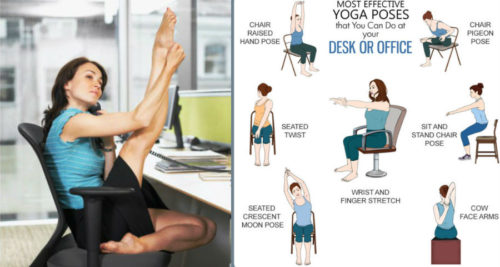

Post your comment